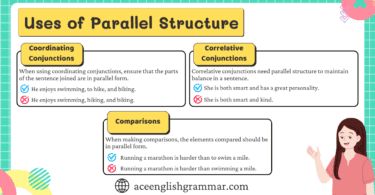Inverted sentences in English occur when the usual order of a subject followed by a verb is reversed. This inversion is often used for emphasis, stylistic variety, or to form questions. While standard English sentences follow the Subject-Verb-Object (SVO) order, inverted sentences often begin with a verb, adverb, or prepositional phrase.
In formal writing and literature, inverted sentences are used to add emphasis or maintain poetic flow. For example, “Never have I seen such beauty” places focus on “never,” emphasizing the rarity of the experience. Inverting the sentence structure is more common in questions, such as “Is he coming to the party?” Here, the verb “is” comes before the subject “he.”
Table of Contents
Types of Inverted Sentences
Inversion for Questions
In everyday language, inversion is most commonly used to form questions. In this case, the auxiliary verb comes before the subject:
- Example: “Did you complete your homework?”
- Explanation: The auxiliary verb “did” precedes the subject “you.”
Inversion with Negative Adverbs
Inversion also occurs after certain negative adverbs like never, rarely, seldom, hardly, scarcely, and barely. The inversion creates a formal, often dramatic tone.
- Example: “Never have I been more surprised.”
- Explanation: The negative adverb “never” appears at the beginning, causing inversion.
Inversion with Conditional Sentences
Sometimes, conditional sentences can be inverted by removing the word “if.” This is more common in formal or literary contexts.
- Example: “Had I known the answer, I would have helped.”
- Explanation: The inversion replaces “If I had known,” emphasizing the condition.
Inversion After “So” and “Such”
Inversion is also used after “so” or “such” to emphasize the intensity of an adjective.
- Example: “So beautiful was the scenery that we stopped to admire it.”
- Explanation: The word “so” leads to inversion, highlighting the beauty of the scenery.
Inversion with Prepositional Phrases
Placing a prepositional phrase at the beginning of a sentence can sometimes lead to inversion.
- Example: “On the hill stood a tall tree.”
- Explanation: The prepositional phrase “on the hill” is fronted, leading to an inverted structure.
When to Use Inverted Sentences
Inverted sentences are commonly used for stylistic purposes, adding variety or emphasis in both writing and speech. Below are common scenarios where inversion is applied:
- Questions – These rely heavily on inversion. Without inversion, many questions wouldn’t make sense.
- Emphasizing Negative Ideas – Starting a sentence with negative adverbs such as “never” or “seldom” inverts the structure to give more weight to the sentence.
- Formal Writing and Speeches – Inverting sentence structures can make formal writing more engaging and dramatic.
- Poetry and Literature – Inversion helps maintain meter and rhyme.
Inverted sentences are an essential aspect of advanced English grammar. They can be tricky at first, but once you understand their structure, you can use them to enhance both written and spoken communication.
Common Mistakes in Using Inverted Sentences
When using inverted sentences, learners often make errors related to auxiliary verbs or incorrect subject-verb agreement. Here are a few common pitfalls:
Forgetting Auxiliary Verbs in Questions
- Incorrect: “He is coming to the party?”
- Correct: “Is he coming to the party?”
Misplacing the Subject and Verb in Negative Inversion
- Incorrect: “Never I have seen such a thing.”
- Correct: “Never have I seen such a thing.”
Incorrect Usage in Conditional Sentences
- Incorrect: “Had known I the answer, I would have helped.”
- Correct: “Had I known the answer, I would have helped.”
To avoid these mistakes, focus on maintaining the correct subject-verb order after the inversion trigger.
Examples of Inverted Sentences in Literature and Formal Writing
Inverted sentences are a stylistic tool used frequently in literature and speeches to add emphasis or maintain a certain tone. Here are a few examples:
- Literature Example: “In silent night when rest I took” (Anne Bradstreet)
- Speech Example: “Not only is this a time for action, but also for reflection.”
In both cases, the inversion helps emphasize the ideas being presented.




